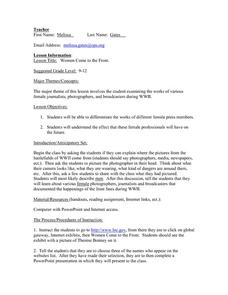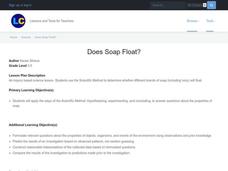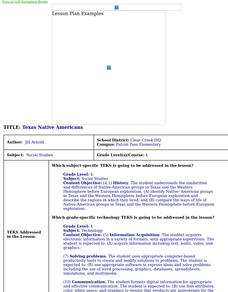Curated OER
Hispanic Immigration
Eighth graders interpret historical evidence presented in primary and secondary resources. In this immigration lesson, students examine sources regarding the history of Hispanic immigration to the United...
Curated OER
Vietnam War: Kennedy Assassination
Students determine how the Kennedy assassination impacted the United States and, more specifically, the Vietnam War. In this 20th century American history lesson, students read books and view video clips of the event and then write...
Curated OER
Ancient Rome: Map Work
Seventh graders explore the Roman Empire. In this ancient Rome lesson, 7th graders participate in activities that require them to examine the history , political structure, chronology, and significant figures of the empire.
Curated OER
The Odyssey Lesson 1
Students explore Greek mythology. In this ancient culture and introduction to The Odyssey literacy lesson, students complete a worksheet accessing their prior knowledge about Greek mythology. Students listen to a passage about the Trojan...
Curated OER
Philanthropy and Philanthropists' Qualities
High schoolers explore the meaning of the term "philanthropy" and the qualities that philanthropists share, especially good character and personal virtue. They list and describe how three volunteer groups act for the common good and...
Curated OER
Michigan's Two Regions
Third graders discuss and compare upper and lower Michigan. In groups they research a list of significant events from Michigan history and then compile the information into an illustrated classroom timeline.
Curated OER
Women Come to the Front
Young scholars examine the role of women in World War II. In this women's history instructional activity, students research selected Internet sources to locate information regarding the roles of selected women in the war. Young scholars...
Curated OER
Road to Revolution (Part 3)
Young scholars explore the road to the American Revolution. For this American history lesson, students research the events in colonial America that led to the Declaration of Independence and the American Revolution. They then create a...
Curated OER
Floating Soap
Learners use the Scientific Method steps to complete an experiment on various brands of soap to determine their floating capabilities. In this scientific method lesson, students write a hypothesis about the ability of various soap bars...
Curated OER
Haiku
Sixth graders study Haiku. In this Haiku lesson, 6th graders explore the history of the poetry form. Students also examine the structure the Japanese poetry as they read examples. Students write their one Haiku.
Curated OER
Do Factions Control Political Parties Today?
Students establish how the first political parties were formed. In this U.S. History lesson plan, students work in groups to share their personal viewpoint on various topics provided by the teacher, then they are assigned to bring...
Curated OER
Space Exploration
Sixth graders investigate the historical even surrounding the Apollo Mission to the Moon. They conduct research specifically to find information about the astronauts on the mission. The students conduct class discussion about the...
Curated OER
Cotton And Child Labor
Eleventh graders investigate the practice of child labor as found in the history of the United States. The teacher reads the class a story from the year of 1914. This creates context for the lesson and then students answer teacher...
Curated OER
Pilgrim's Progress- Get on the Boat
Students investigate the Pilgrims and their journey. In this history lesson, students role play the journey of the Pilgrims and discuss the conditions of the Mayflower. Students record their feelings about the "journey" in a journal.
Curated OER
Doing the Right Thing
Students consider the payoffs of doing the right thing. In this philanthropy lesson, students examine the virtue of courage in Jackie Robinson's life and in their own.
Curated OER
The Black Plague: International Insects
Sixth graders research conditions that caused 16th Century Black Plague and led to downfall of Europe, and examine causes and effects of population density, disease, and invention.
Curated OER
Volunteering Requires Freedom of Choice
Students explore ways to volunteer. In this volunteerism and philanthropy lesson, students brainstorm how the early Americans benefited from philanthropy, then discuss how others benefit from our philanthropy and how we choose ways to...
Curated OER
Planting Seeds of Philanthropy
Middle schoolers explore the importance of maintaining a democracy through philanthropic actions. In this character education lesson, students discover what the Japanese internment camps were, and why they were an infringement on...
Curated OER
Texas Native Americans
Fourth graders research the Native Americans of Texas using the Internet. They create a Power Point presentation over the four Indian tribes of Texas - Caddo, Jumano, Karankawa, Apache.
Curated OER
Pearl Harbor vs September 11 Attack
High schoolers compare and contrast the events of the Pearl Harbor Attack and the attack on September 11, 2001 by examining the similarities and differences between these two events.
Curated OER
The Women's Suffrage Movement Signature Debacle
Students examine the Women's Suffrage Movement in Nebraska. In this women's rights lesson, students explore primary and secondary sources regarding suffrage in the state and obstacles that women in the state faced when it came to casting...
Curated OER
Manuelito's Role as a Leader
Learners research Manuelito's involvement with the treaty which freed the Navajo from Fort Sumner, his leadership role in keeping peace, the details of his meeting with Grant, his support of education, and his disappointment with Indian...
Curated OER
How Music Motivates
Students form conclusions regarding the motivational effects of music on the mind during the Civil Rights era. In this Civil Rights movement lesson, students describe how music motivates, describe the motivational role in freedom songs...
Curated OER
Ratios
Learners identify ratios to compare quantities and understand proportions. In this math lesson plan, students work in groups and use facts from the Holocaust to calculate ratios and percentages.























